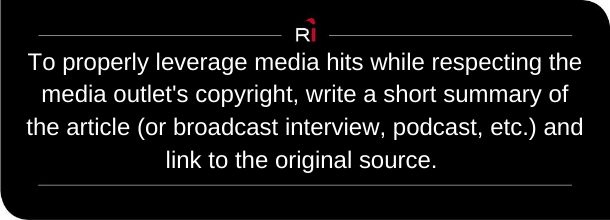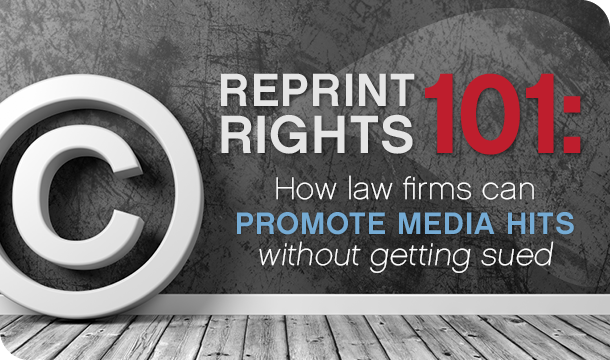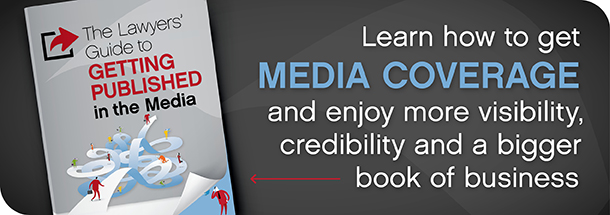Reprint Rights 101: How law firms can promote media hits without getting sued
You get a solid quote in a key publication, or publish an insightful article in a legal trade magazine, and you want everyone to know (particularly potential clients). So, you post the full text of the article to your firm’s website, send it to your email list and put out some social media posts linking to it for good measure.
Good marketing, right?
While promoting your media coverage is important (and kudos to you for recognizing that), unfortunately you’ve left yourself open to legal action from the media outlet because you’ve just violated their copyright.
Don’t feel too badly. This happens fairly often, and we’ve found that lawyers and law firms are among some of the worst offenders. Which is more than a little ironic, because, you know, laws…
The good news is that there are ways to leverage your media hits while staying on the right side of the law — and in the good books of the media outlets that cover you.
When in doubt, link to the original article
To properly leverage media hits while respecting the media outlet’s copyright, write a short summary of the article (or broadcast interview, podcast, etc.) and link to the original source.

With the rise of SEO due to the dominance of search engines like Google, so-called referral links from other quality websites are internet gold. So, directly linking from your firm’s website to a media outlet’s article throws a bit of SEO juice their way. It’s a win-win. This is the way we nearly always suggest promoting media coverage for our law firm PR clients, particularly if it’s a story written entirely by the media outlet.
Here’s an example from our own website, when our principal and president, Michelle Calcote King, was interviewed for an article by Answering Legal, “Legal Marketing Tips: How to Approach Selling Your Services During The COVID-19 Crisis?”
Note the following best practices:
1) The link should incorporate keyword-rich text. In other words, your link should not be “click here” or “read more here.” Instead, use the title of the article or some other text that describes the content of the article. That way the firm’s website will get a boost in Google’s eyes as a good source of information on the topic. (Plus a bonus for adding fresh content, yay!)
2) The summary should feature concise language that makes use of keywords people will most likely use to search about that topic. The summary doesn’t have to be long. It’s the keywords that matter. (Just make sure to use complete sentences that make grammatical sense — no Black Hat SEO tactics here!)
3) Name the lawyer who’s quoted and link to their bio page.
4) On social media, share the link to the summary on the firm’s website, not the link to the original article itself. That way you’re sending visitors to your website first, and then on to the media outlet. It’s all about capturing that traffic.
Promoting bylined articles
Writing short summaries with a link to the original article should be the default option for promoting articles written by a media outlet. However, what should you do when one of your attorneys authors a bylined article in a media outlet? Can you post the full text or a PDF of that article?
Essentially, it comes down to the publishing agreement that the lawyers who wrote the piece signed when they first landed the opportunity to write the article with the media outlet. Nearly every media outlet uses standard contracts that spell out who owns the rights to the text. Some publications retain everything, even though they didn’t author the article. That’s a pretty rare case, however. Most will allow authors to make use of the text of their bylined article for marketing purposes if they give credit to the outlet as the original publisher.
This is what ALM does, for example. Their publishing agreement allows for authors to use the text of their bylined articles on their websites as long as certain language is included. For example, the New York Law Journal requests this text:
Reprinted with permission from the ISSUE DATE edition of the “New York Law Journal” © 2020 ALM Media Properties, LLC. All rights reserved. Further duplication without permission is prohibited. ALMReprints.com – 877-257-3382 – reprints@alm.com.
Bloomberg Law works in the same way. This is the language they ask authors to add to website posts:
Reproduced with permission. Published MONTH DAY, YEAR. Copyright 2020 The Bureau of National Affairs, Inc. 800-372-1033. For further use, please visit http://www.bna.com/copyright-permission-request/
Even though ALM and Bloomberg Law allow for marketing uses, we always make sure to get an editor’s permission to do so in writing through email. That way there will be no misunderstanding.
Other outlets have similar policies. Law360 actually provides a pdf of the article without its masthead or other branding for authors to post to websites and social media.
Note that none of these outlets will allow a firm to post an article with the publication’s branding and masthead. That’s considered a no-go. It’s just text that’s allowed.
Pay for reprints if you want masthead, branding
Sometimes, an official reprint (with a publication’s masthead and branding) is the only way to go. This is particularly the case when including full media clips in RFP responses, marketing collateral, presentations or other materials where appearances matter.
Reprints can be expensive, however, so they are best used sparingly and only for the most impressive media hits. The terms also vary between outlets. Some will allow a one-time use (which can be cheaper) while others are more broad with their license (but that is likely to cost more). Publishers may offer a lower rate if a firm is purchasing reprints for multiple articles, or include a certain number of complimentary reprints with sponsorship or advertising contracts. It really helps to ask.
Information on how to obtain reprints can be found prominently on the websites of most media outlets, usually at the bottom. This is a way to generate revenue for them, so they make it very easy to find. It also keeps people from using the excuse that they just couldn’t locate the information so they figured they were fine to use an article.
Take a step back, assess and reduce your risk
If all of this sounds complicated and time-consuming, well, it is. But dealing with a copyright takedown notice is not exactly a fun time either. Ignorance is definitely not bliss when it comes to posting media clips properly.
We’re often asked by our law firm clients if they’re really taking a risk posting the full text of articles or branded PDFs to their websites. (Which, again, irony…) Our answer is always the same: YES. A firm may get away with it, and it may not. But rolling those dice when there are easy ways to avoid the problem makes no sense.
It starts with understanding a media outlet’s copyright policies, reading through publishing agreements and scanning the reprints section of their websites. The information is all there. It just takes a bit of time to look into it. And, most editors or reporters will be happy to tell you what is considered fair marketing use and how to properly post articles to your website. (Pro-tip: If you make notes as you go and save them somewhere handy you’ll only have to do this once for every outlet.)
This also doesn’t mean you have to be paranoid. You don’t need to scrutinize every publishing agreement and demand changes to suit how you will use the content, for example. For one, a publisher won’t alter a contract just for you, or they’d have to do it for everyone. It’s simply about taking reasonable precautions.
It is possible to both leverage media hits and remain compliant with copyright law. Still confused? We are more than happy to help you out and make it all clear. Just drop us a note or post a comment below! Really brave? Share an “I was XX years old when I discovered you couldn’t do this” story with us! We won’t tell anyone.










